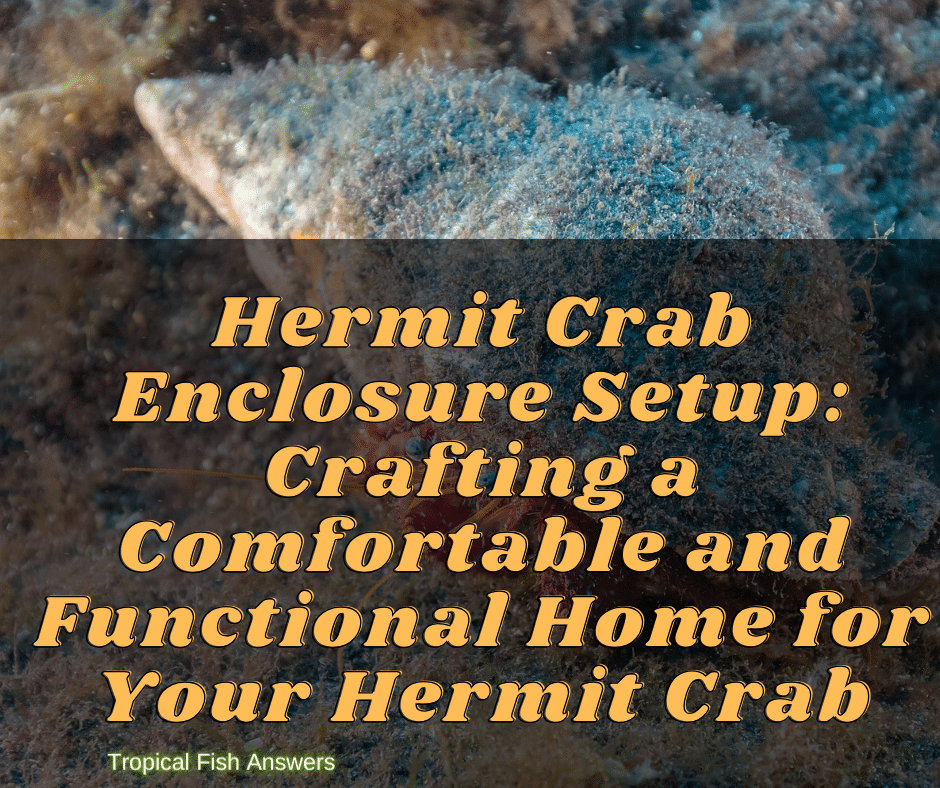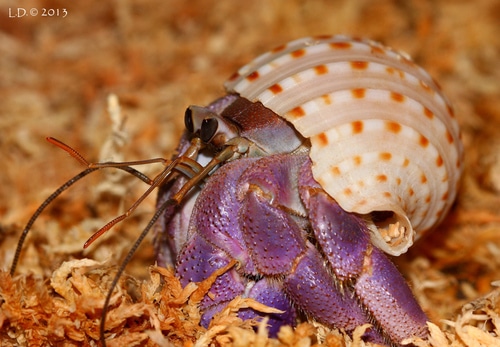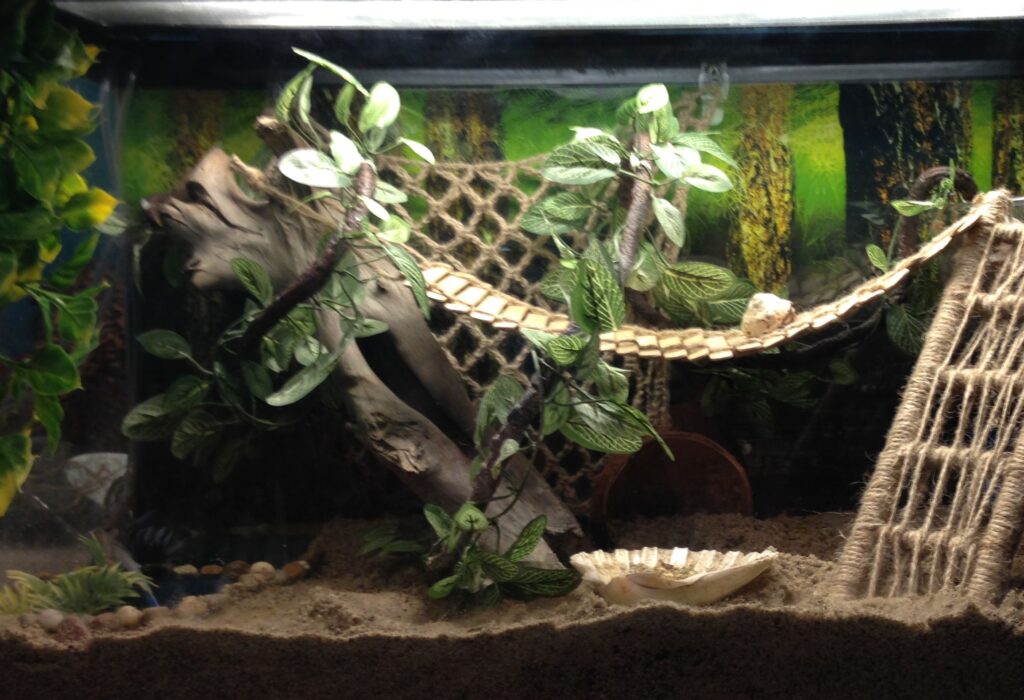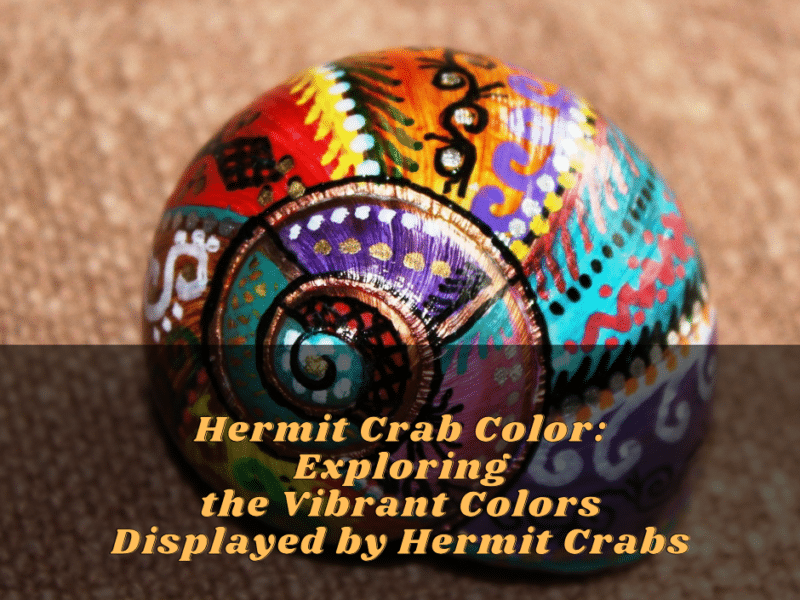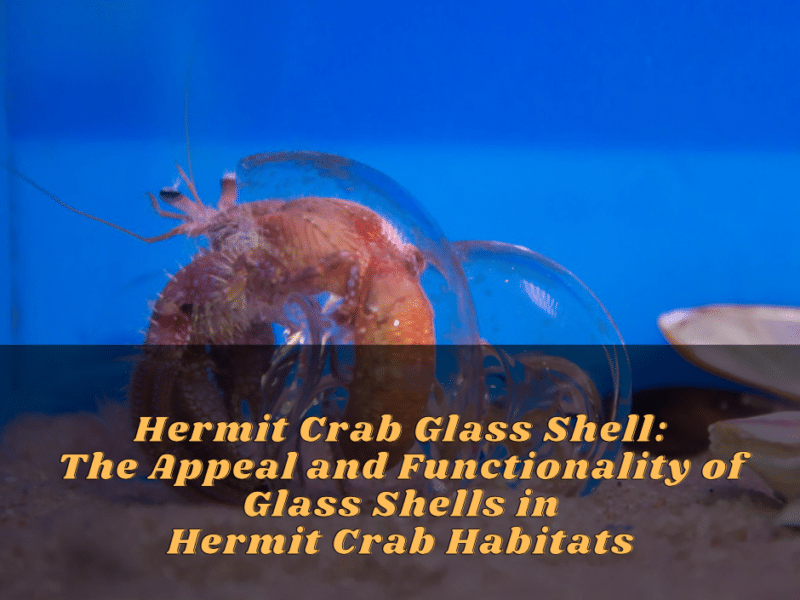Introduction
Creating a comfortable and functional home for your hermit crab is crucial for its health and well-being. Just like any other pet, hermit crabs require a suitable environment that replicates their natural habitat. In this guide, we will provide a brief overview of the importance of a proper hermit crab enclosure setup, along with key elements to consider for creating the perfect habitat.
A Brief Overview Of The Importance Of A Proper Hermit Crab Enclosure Setup
A proper hermit crab enclosure setup is essential for several reasons. Firstly, it ensures that your hermit crab feels safe and secure in its new home. Hermit crabs are naturally shy creatures and need a habitat that offers plenty of hiding spots and shelters.
Secondly, a well-designed enclosure allows your hermit crab to exhibit its natural behaviors. These include climbing, digging, and exploring. Providing the necessary space and substrate for these activities is vital for their physical and mental stimulation.
Moreover, the right enclosure setup helps to maintain proper humidity levels and temperature. Hermit crabs require a specific range of temperature and humidity to thrive. By providing the correct conditions, you can ensure the overall health and longevity of your pet.
Lastly, a well-maintained enclosure minimizes the risk of stress-related issues and illnesses. Stress can weaken the immune system of hermit crabs, making them more susceptible to diseases. Therefore, a clean and suitable habitat is crucial for maintaining their overall health and happiness.
To create a comfortable and functional home for your hermit crab, consider the following key elements:
- Enclosure Size: Provide a spacious enclosure that allows your hermit crab to move around freely. A general guideline is to have at least a 5-gallon tank for one crab, with an additional gallon for each additional crab.
- Substrate: Choose a suitable substrate, such as coconut fiber or a sand and soil mix, to replicate the natural habitat of hermit crabs. Make sure to create different areas with varying levels of moisture to cater to their needs.
- Hiding Spots: Include a variety of shelters, such as caves, rocks, and driftwood, where your hermit crab can retreat and feel secure. These hiding spots should be large enough for the crab to fit comfortably.
- Temperature and Humidity: Maintain a temperature range of 75-85°F (24-29°C) and a humidity level of 70-80%. This can be achieved with the help of a heat source, such as a heat lamp or under-tank heater, and a hygrometer to monitor humidity.
- Water and Food: Provide both fresh and saltwater dishes for your hermit crab to drink and bathe in. Use dechlorinated water and sea salt to create a suitable saltwater solution. Additionally, offer a balanced diet of hermit crab pellets, fresh fruits, vegetables, and occasional protein sources.
Taking the time to create an appropriate hermit crab enclosure setup will ensure the well-being and happiness of your pet. By replicating their natural environment and providing the necessary elements for their physical and mental stimulation, you can create a comfortable and functional home that your hermit crab will thrive in.
Hermit Crab Habitat Basics
Essential Elements For A Healthy Crabitat
Creating a comfortable and functional home for your hermit crab is crucial for its health and well-being. To ensure your hermit crab thrives in its habitat, there are a few essential elements you need to consider.
a. Substrate: Choose a suitable substrate that replicates the natural habitat of hermit crabs. Options like coconut fiber or a sand and soil mix work well. The substrate should be deep enough to allow your hermit crab to burrow and dig.
b. Hiding spots: Provide a variety of shelters such as caves, rocks, and driftwood. These hiding spots give your hermit crab a sense of security and privacy.
c. Temperature and humidity: Maintain the appropriate temperature range of 75-85°F (24-29°C) and humidity level of 70-80%. Use a reliable thermometer and hygrometer to monitor and regulate the conditions in the habitat. Employ heat sources like a heat lamp or under-tank heater to maintain the right temperature.
d. Water and food: Provide both fresh and saltwater dishes for your hermit crab. Ensure the water is dechlorinated and use sea salt to create a suitable saltwater solution. Offer a balanced diet of hermit crab pellets, fresh fruits, vegetables, and occasional protein sources.
Minimum Size Requirements For A Hermit Crab Habitat
The size of your hermit crab habitat is crucial for its overall well-being. Each hermit crab requires sufficient space to move around and exhibit natural behaviors. Here are some minimum size guidelines to consider:
a. 5-gallon tank per crab: Provide at least a 5-gallon tank for one hermit crab. For each additional hermit crab, add an extra gallon to the tank size.
b. Habitat dimensions: As a general rule, the habitat should be long and wide enough to accommodate your hermit crab’s size, with plenty of room for them to freely explore and climb.
Remember, these are minimum size requirements, and providing a larger habitat is always better. More space allows for better ventilation and reduces the risk of stress-related issues.
Crafting a comfortable and functional home for your hermit crab requires careful consideration of these factors. By providing the essential elements for a healthy crabitat and ensuring the habitat meets the minimum size requirements, you can create an environment where your hermit crab will thrive.
Creating A Theme For Your Crabitat
Fun Ideas For Themed Hermit Crab Enclosures
Creating a themed hermit crab enclosure adds an extra touch of creativity and fun to your pet’s habitat. Here are some exciting ideas to inspire you:
a. Beach Paradise: Recreate a tropical beach atmosphere with sand, seashells, palm trees, and miniature beach chairs. Add a small pool area for your hermit crab to splash around in.
b. Pirate Adventure: Transform your crabitat into a pirate’s treasure island with fake jewels, a pirate ship, treasure chests, and a skeleton figure. Don’t forget the pirate flag!
c. Fantasy Forest: Create a mystical forest setting with artificial trees, mushrooms, and fairies. Add colorful flowers and hanging vines for an enchanting touch.
d. Underwater World: Bring the ocean to life with coral reefs, underwater plants, and colorful fish decorations. Use blue lighting to simulate the underwater ambiance.
Decorative Elements To Enhance Your Crabitat
In addition to the themed ideas mentioned above, incorporating various decorative elements can further enhance your hermit crab’s habitat. Here are some suggestions:
a. Natural Materials: Use driftwood, rocks, and moss to create a natural and realistic environment. These materials also provide climbing opportunities for your crab.
b. Artificial Plants: Add artificial plants to create a lush and visually appealing habitat. Choose plants with different heights and textures to provide variation.
c. Seashells and Beach Accessories: Scatter seashells, starfish, and other beach-themed accessories throughout the enclosure. These items add visual interest and promote exploration.
d. Hanging Hammocks: Install small hammocks for your hermit crab to rest on. These cozy spots provide a comfortable resting place and mimic their natural hanging behavior.
Remember to ensure that all decorative elements are safe for your hermit crab. Avoid using anything that may contain toxic substances or pose a choking hazard.
By incorporating a theme into your hermit crab enclosure and adding decorative elements, you create an engaging and visually stimulating environment for your pet. Get creative, have fun, and enjoy watching your hermit crab thrive in its newly themed crabitat!
Setting Up The Terrarium
When it comes to setting up a comfortable and functional home for your hermit crab, there are a few key factors to consider. Creating the right environment and placing the terrarium correctly are crucial for the well-being of your pet. Here, we will provide some helpful tips on maintaining the right environment and positioning the terrarium for optimal results.
Tips For Maintaining The Right Environment For Your Hermit Crabs
Creating a suitable environment for your hermit crabs is essential for their overall health and well-being. Here are some tips to ensure you provide the right conditions:
- Temperature and Humidity: Hermit crabs require a warm and humid environment, as they originate from tropical regions. Maintain temperatures between 75 to 85 degrees Fahrenheit (24 to 29 degrees Celsius) and humidity levels around 70-80%. You can achieve this by using a heat pad and a hygrometer to monitor humidity.
- Substrate: Choose a substrate that can hold moisture, such as coconut fiber or sand mixed with eco-earth. This will provide a suitable base for burrowing and help maintain the humidity levels.
- Lighting: Hermit crabs require a day and night cycle, so it’s important to provide a light source. Use a fluorescent bulb to mimic natural daylight and provide a consistent lighting schedule.
- Water and Saltwater: Provide fresh water for drinking and a separate dish of saltwater for bathing. Use an aquarium water conditioner to remove chlorine and other harmful chemicals from tap water.
- Hideouts and Climbing Structures: Offer a variety of hideouts and climbing structures, such as rocks, driftwood, and empty shells. These will provide your hermit crabs with places to explore, hide, and molt.
Placement And Positioning Of The Terrarium
Finding the right location for your hermit crab’s terrarium is crucial for their well-being. Consider the following factors when positioning the enclosure:
- Avoid Direct Sunlight: Direct sunlight can cause excessive heat and temperature fluctuations. Place the terrarium away from windows or use curtains to filter sunlight.
- Adequate Ventilation: While hermit crabs require high humidity, it’s also important to ensure proper ventilation. Avoid placing the terrarium in a small, enclosed space to prevent stagnant air.
- Stable Environment: Choose a location that maintains a stable temperature and humidity level. Avoid placing the terrarium near air vents, drafty areas, or areas with fluctuating temperatures.
- Minimal Noise and Disturbance: Hermit crabs are sensitive to noise and vibrations. Avoid placing the terrarium in high-traffic areas or near loud appliances to provide a calm and stress-free environment.
By following these tips and creating the right environment, you can ensure a comfortable and functional home for your hermit crab. Always monitor the temperature, humidity, and other environmental factors to maintain optimal conditions. With the right setup, your hermit crab will thrive in its new home, providing you with years of joy and entertainment.
Socializing Hermit Crabs
The Social Nature Of Hermit Crabs
Hermit crabs are social creatures and thrive in the presence of their own kind. While they may seem solitary, they actually benefit from interaction with other hermit crabs. Socializing provides them with opportunities for grooming, mating, and companionship, which promotes their overall well-being.
When hermit crabs interact, they engage in behaviors such as climbing on top of each other, inspecting shells, and even swapping shells. These activities are essential for their physical and mental stimulation. However, it’s important to note that not all hermit crabs get along, and some can display aggressive behavior. It is crucial to introduce new crabs gradually and monitor their interactions to ensure a harmonious social environment.
Recommendations For Housing Multiple Hermit Crabs Together
If you decide to house multiple hermit crabs together, there are a few key recommendations to ensure their well-being:
- Provide adequate space: Each hermit crab should have enough space to move around and find its own hiding spots. Aim for a tank size of at least 10 gallons per hermit crab.
- Offer a variety of shells: Hermit crabs are known for changing shells regularly. Make sure to provide a selection of different-sized shells for each crab to choose from. This will help avoid conflicts over shells and ensure each crab has a comfortable home.
- Monitor behavior: Keep an eye on their interactions to ensure peaceful coexistence. Look for signs of aggression, such as excessive climbing, shell fighting, or pinching. If any aggression is observed, it may be necessary to separate the crabs to prevent injury.
- Provide plenty of hiding spots: Hermit crabs thrive when they have ample hiding spots and climbing structures. Offer a variety of rocks, branches, and hideouts for them to explore and find refuge.
- Offer a balanced diet: Proper nutrition is essential for healthy hermit crabs. Provide a varied diet that includes commercial crab food, fresh fruits and vegetables, and protein sources such as dried shrimp or mealworms. Make sure to remove uneaten food to maintain a clean environment.
Remember, not all hermit crabs will get along, and some may prefer a solitary lifestyle. It is essential to observe each crab’s behavior and make adjustments accordingly. By following these recommendations and providing a suitable social environment, you can ensure that your hermit crabs lead happy and fulfilling lives in their enclosure.
Upgrading And Expanding Your Crabitat
Factors To Consider Before Upgrading Your Crabitat
Before you embark on upgrading and expanding your hermit crab enclosure, there are several important factors to consider:
- Size and Space: Assess the current size of your crabitat and determine if it provides enough space for your hermit crabs. Adequate space is crucial for their well-being, allowing them to move around, explore, and exercise.
- Tank Material: Consider the material of the tank, as different materials may have different advantages and disadvantages. Glass tanks are commonly used, as they are easy to clean and provide good visibility. However, plastic tanks are lightweight and less likely to break.
- Temperature and Humidity: Evaluate if the temperature and humidity levels in your current enclosure are suitable for your hermit crabs’ needs. Hermit crabs require a warm and humid environment to thrive, so make sure to provide the right conditions.
- Accessibility: Check if the crabitat is easily accessible for maintenance and cleaning. It should have openings or removable lids that allow you to reach every corner easily.
- Compatibility: Consider the compatibility of different hermit crab species before housing them together. Some species may have specific requirements or exhibit different behaviors that could impact the overall dynamics of the enclosure.
Steps To Take When Expanding Your Hermit Crab Enclosure
Once you have considered the above factors, you can start expanding and upgrading your hermit crab enclosure using the following steps:
- Choose a larger tank: Select a tank that provides ample space for your hermit crabs to grow and move around comfortably. A general guideline is to have at least 10 gallons of space per hermit crab.
- Create a natural habitat: Incorporate natural elements such as rocks, branches, and plants to mimic their natural environment. This will provide mental stimulation, opportunities for climbing, and hiding spots.
- Enhance the substrate: Use a substrate that supports burrowing, such as a mix of sand and coconut fiber. This will allow your hermit crabs to indulge in their natural behavior and create tunnels.
- Install proper lighting: Provide appropriate lighting sources to simulate day and night cycles. Natural sunlight or full-spectrum UVB bulbs can help meet their lighting needs.
- Upgrade the heating and humidity systems: Ensure your hermit crabs have sufficient warmth and humidity levels by using a heat pad, heat lamp, or fogger. Regularly monitor the temperature and humidity to maintain ideal conditions.
- Offer a variety of shells and hiding spots: Provide a diverse selection of shells for your hermit crabs to choose from. Additionally, offer plenty of hiding spots and climbing structures to enrich their environment.
By considering these factors and taking the necessary steps, you can create a comfortable and functional home for your hermit crabs. Remember to regularly monitor and maintain the enclosure to ensure the well-being of your beloved crustacean companions.
Conclusion
Creating a comfortable and functional hermit crab enclosure is crucial for the well-being and happiness of your hermit crabs. By considering factors such as size, tank material, temperature and humidity, accessibility, and compatibility, you can ensure that your crabitat meets their needs.
Expanding and upgrading your hermit crab enclosure involves choosing a larger tank, creating a natural habitat with rocks, branches, and plants, enhancing the substrate for burrowing, installing proper lighting, upgrading the heating and humidity systems, and offering a variety of shells and hiding spots.
A well-designed hermit crab enclosure provides ample space for your crabs to move around, explore, and exercise. It mimics their natural environment and provides mental stimulation through natural elements. The substrate allows them to engage in their natural burrowing behavior, while proper lighting and heating systems ensure they have the right conditions for their well-being. Offering a variety of shells and hiding spots allows them to feel secure and comfortable in their environment.
Crafting a comfortable and functional home for your hermit crabs not only ensures their physical health but also their mental well-being. A well-maintained crabitat promotes their natural behaviors, reduces stress, and creates a safe and enjoyable living space. By regularly monitoring and maintaining the enclosure, you can ensure the continued happiness of your beloved crustacean companions.
Remember, providing a comfortable and functional hermit crab enclosure is a continuous process. As your hermit crabs grow and change, their needs may evolve, and you may need to make adjustments to their habitat accordingly. By staying attentive and responsive to their needs, you can create an environment that promotes their overall health and happiness. So take the time to carefully craft their crabitat and enjoy watching your hermit crabs thrive in their new home.
FAQ: Hermit Crab Enclosure Setup
Crafting a Comfortable and Functional Home for Your Hermit Crab
Q: What are the essential furnishings needed for a hermit crab enclosure?
A: There are three necessities for furnishing the hermit crab cage: items for climbing, a water bowl, and a food dish. Hermit crabs love to climb, so providing them with Choya (or cholla) wood is ideal for exercise.
Q: Do hermit crabs require a specific environment?
A: Yes, hermit crabs come from warm tropical climates and therefore need a warm and humid environment to thrive. Ensuring their living space replicates these conditions is essential for their health and comfort.
Q: What type of substrate should I use for the enclosure?
A: Sand is the recommended substrate for hermit crab enclosures because they enjoy burrowing into it. Playground sand, which can be found at home improvement stores, is a suitable and cost-effective option. Aquarium sand can also be used. It’s recommended to rinse, dry, and bake the sand at 300 degrees Fahrenheit to sterilize it. It can be reused after washing.
Q: What kind of tank is suitable for hermit crabs?
A: Both glass and plastic tanks are suitable for hermit crabs. A 10-gallon aquarium with a lid is a good choice. Opt for a sliding glass lid to control humidity effectively. It is important to note that hermit crab kits sold with small plastic homes and accessories are often too small for long-term living, but can be used temporarily or as isolation tanks.
Q: Can hermit crabs be kept alone or do they prefer company?
A: Despite their name, hermit crabs are actually social creatures and are best kept in groups. They thrive in the company of their fellow crabs, so it is recommended to have multiple crabs in the enclosure.
We hope these frequently asked questions have provided you with useful insights on creating a comfortable and functional home for your hermit crab. By following these guidelines and providing the right environment and furnishings, you can ensure your pet’s happiness and well-being.
